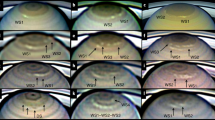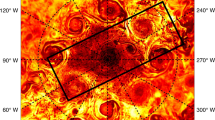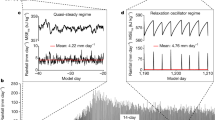Abstract
A giant storm erupted on Saturn in December 2010. It produced intense lightning and cloud disturbances and encircled the planet in six months. Six giant storms—also called Great White Spots—have been observed on Saturn since 1876, recurring every 20 to 30 years and alternating between mid-latitudes and the equator. Here we use thermodynamic arguments to demonstrate that the quasi-periodic occurrence of Saturn’s giant storms can be explained by a water-loading mechanism, in which moist convection is suppressed for decades owing to the relatively large molecular weight of water in a hydrogen–helium atmosphere. We find that the interaction between moist convection and radiative cooling in the troposphere above the cloud base produces an oscillation that leads to giant storm generation with a period of approximately 60 years for either mid-latitudes or the equator, provided the mixing ratio of water vapour in the troposphere exceeds 1.0%. We use a two-dimensional axisymmetric dynamic model and a top-cooling convective adjustment scheme to apply our conceptual model to Saturn. For a water vapour mixing ratio of 1.1%, simulated storms show a recurrence interval, ammonia depletion and tropospheric warming that are consistent with 2010 observations. Jupiter’s atmosphere is more depleted in water than Saturn, which may explain its lack of planet-encircling storms.
This is a preview of subscription content, access via your institution
Access options
Subscribe to this journal
Receive 12 print issues and online access
$259.00 per year
only $21.58 per issue
Buy this article
- Purchase on Springer Link
- Instant access to full article PDF
Prices may be subject to local taxes which are calculated during checkout





Similar content being viewed by others
References
Sanchez-Lavega, A. Saturn’s Great White Spots. Chaos 4, 341–353 (1994).
Sanchez-Lavega, A. & Battaner, E. The nature of Saturns atmospheric Great White Spots. Astron. Astrophys. 185, 315–326 (1987).
Sayanagi, K. M. et al. Dynamics of Saturn’s Great Storm of 2010–2011 from Cassini ISS and RPWS. Icarus 223, 460–478 (2013).
Sanchez-Lavega, A. et al. Deep winds beneath Saturn’s upper clouds from a seasonal long-lived planetary-scale storm. Nature 475, 71–74 (2011).
Fischer, G. et al. A giant thunderstorm on Saturn. Nature 475, 75–77 (2011).
Achterberg, R. K. et al. Changes to Saturn’s zonal-mean tropospheric thermal structure after the 2010–2011 northern hemisphere storm. Astrophys. J. 786, 92–100 (2014).
Janssen, M. A. et al. Saturn’s thermal emission at 2.2-cm wavelength as imaged by the Cassini RADAR radiometer. Icarus 226, 522–535 (2013).
Laraia, A. L. et al. Analysis of Saturn’s thermal emission at 2.2-cm wavelength: Spatial distribution of ammonia vapor. Icarus 226, 641–654 (2013).
Dyudina, U. A. et al. Lightning storms on Saturn observed by Cassini ISS and RPWS during 2004–2006. Icarus 190, 545–555 (2007).
Stoker, C. R. Moist convection—a mechanism for producing the vertical structure of the Jovian equatorial plumes. Icarus 67, 106–125 (1986).
Hueso, R. & Sanchez-Lavega, A. A three-dimensional model of moist convection for the giant planets II: Saturn’s water and ammonia moist convective storms. Icarus 172, 255–271 (2004).
Guillot, T. Condensation of methane, ammonia, and water and the inhibition of convection in giant planets. Science 269, 1697–1699 (1995).
Sugiyama, K. et al. Intermittent cumulonimbus activity breaking the three-layer cloud structure of Jupiter. Geophys. Res. Lett. 38, 201–206 (2011).
Sugiyama, K., Nakajima, K., Odaka, M., Kuramoto, K. & Hayashi, Y. Y. Numerical simulations of Jupiter’s moist convection layer: Structure and dynamics in statistically steady states. Icarus 231, 407–408 (2014).
Emanuel, K. A. Atmospheric Convection (Oxford Univ. Press, 1994).
Orton, G. S. & Ingersoll, A. P. Saturn’s atmospheric temperature structure and heat budget. J. Geophys. Res. 85, 5871–5881 (1980).
Asplund, M., Grevesse, N., Sauval, A. J. & Scott, P. The chemical composition of the Sun. Annu. Rev. Astron. Astrophys. 47, 481–522 (2009).
Fletcher, L. N. et al. Sub-millimetre spectroscopy of Saturn’s trace gases from Herschel/SPIRE. Astron. Astrophys. 539, A44 (2012).
Fletcher, L. N., Orton, G. S., Teanby, N. A., Irwin, P. G. J. & Bjoraker, G. L. Methane and its isotopologues on Saturn from Cassini/CIRS observations. Icarus 199, 351–367 (2009).
Fletcher, L. N., Orton, G. S., Teanby, N. A. & Irwin, P. G. J. Phosphine on Jupiter and Saturn from Cassini/CIRS. Icarus 202, 543–564 (2009).
Niemann, H. B. et al. The Galileo probe mass spectrometer: Composition of Jupiter’s atmosphere. Science 272, 846–849 (1996).
Lindal, G. F., Sweetnam, D. N. & Eshleman, V. R. The atmosphere of Saturn—an analysis of the Voyager radio occultation measurements. Astronom. J. 90, 1136–1146 (1985).
Fletcher, L. N. et al. Thermal structure and dynamics of Saturn’s northern springtime disturbance. Science 332, 1413–1417 (2011).
Emanuel, K. A., Neelin, J. D. & Bretherton, C. S. On large-scale circulations in convecting atmospheres. Q. J. R. Meteorol. Soc. 120, 1111–1143 (1994).
Charney, J. G. & Eliassen, A. On the growth of the hurricane depression. J. Atmos. Sci. 21, 68–75 (1964).
LeVeque, R. J. Finite Difference Methods for Ordinary and Partial Differential Equations: Steady-State and Time-Dependent Problems (Society for Industrial and Applied Mathematics, 2007).
Shu, C. W. & Osher, S. Efficient implementation of essentially non-oscillatory shock-capturing schemes. J. Comput. Phys. 83, 32–78 (1989).
Roe, P. L. Approximate Riemann solvers, parameter vectors, and difference schemes. J. Comput. Phys. 135, 250–258 (1997); (Reprinted from the J. Comput. Phys. 43, 357–372 (1981)).
Shu, C. W. Total-variation-diminishing time discretizations. SIAM J. Sci. Stat. Comp. 9, 1073–1084 (1988).
Acknowledgements
This research was supported by the National Science Foundation, award number AST-1109299, and by the Cassini Project of NASA. We thank D. Yang for discussions on moist convection.
Author information
Authors and Affiliations
Contributions
Both authors participated equally in formulating the model and interpreting the final results. C.L. wrote the code for the numerical model and convective adjustment scheme.
Corresponding author
Ethics declarations
Competing interests
The authors declare no competing financial interests.
Supplementary information
Supplementary Information
Supplementary Information (PDF 4132 kb)
Rights and permissions
About this article
Cite this article
Li, C., Ingersoll, A. Moist convection in hydrogen atmospheres and the frequency of Saturn’s giant storms. Nature Geosci 8, 398–403 (2015). https://doi.org/10.1038/ngeo2405
Received:
Accepted:
Published:
Issue Date:
DOI: https://doi.org/10.1038/ngeo2405
This article is cited by
-
The Deep Oxygen Abundance in Solar System Giant Planets, with a New Derivation for Saturn
Space Science Reviews (2024)
-
Jupiter Science Enabled by ESA’s Jupiter Icy Moons Explorer
Space Science Reviews (2023)
-
Uranus and Neptune are key to understand planets with hydrogen atmospheres
Experimental Astronomy (2022)
-
The water abundance in Jupiter’s equatorial zone
Nature Astronomy (2020)
-
Cassini Exploration of the Planet Saturn: A Comprehensive Review
Space Science Reviews (2020)



